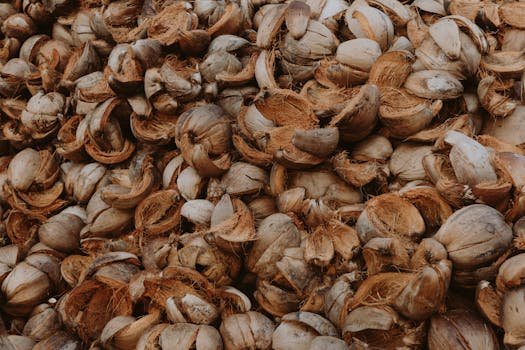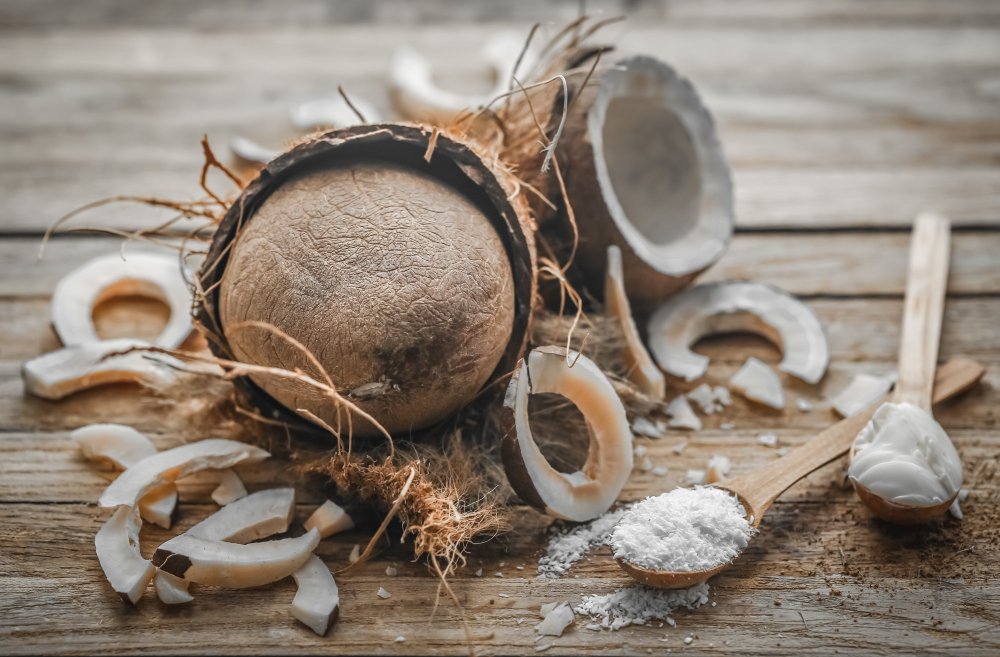The coconut palm, a symbol of tropical paradise, yields far more than just its delicious fruit. Vast quantities of coconut waste – husks, shells, leaves, and water – are generated annually, often ending up in landfills, contributing to environmental problems. However, this seemingly worthless byproduct holds immense potential. Recent innovations are transforming coconut waste from a disposal challenge into a valuable resource for various modern industries, offering a sustainable and economically viable solution to a global waste management issue. This article explores the exciting developments in processing coconut waste and its remarkable transformation into a treasure trove of useful materials.
Unveiling Coconut Waste’s Hidden Potential
Coconut waste, often perceived as trash, is actually a rich source of valuable components. The husk, for instance, is composed of coir fiber, a naturally strong and durable material. Coconut shells, surprisingly, are rich in cellulose and lignin, ideal for biofuel production. The coconut water, though often discarded, contains essential nutrients and can be utilized in various food and cosmetic applications. Even the leaves, typically used for thatching, can be processed into compost or used for creating biochar. These seemingly disparate components possess unique properties, making them highly versatile and suitable for a multitude of applications across diverse industries. The key lies in unlocking their potential through innovative processing techniques. Ignoring this hidden potential is not only environmentally irresponsible but also economically unwise, as we are overlooking a vast reservoir of readily available resources.
The sheer volume of coconut waste generated globally presents a significant opportunity. Millions of tons are discarded annually, creating substantial environmental burdens. This waste contributes to landfill overflow, methane emissions, and soil contamination. However, by effectively processing this waste, we can significantly reduce these negative environmental impacts. Moreover, the transformation of waste into valuable products creates new economic opportunities, particularly in developing countries where coconut cultivation is prevalent. This shift from a linear “take-make-dispose” model to a circular economy approach offers a sustainable and profitable pathway for both environmental protection and economic growth. The potential for job creation and economic empowerment is substantial.
Innovative research and development are continuously uncovering new possibilities within coconut waste. Scientists are exploring advanced techniques for extracting high-value compounds from these materials, such as bioactive compounds with potential applications in pharmaceuticals and cosmetics. Furthermore, ongoing research focuses on improving the efficiency and cost-effectiveness of processing methods, making the utilization of coconut waste increasingly attractive for businesses. This constant evolution in processing techniques ensures that the potential of coconut waste is continually being maximized, leading to a wider range of applications and a more sustainable future. The potential for discovery and innovation remains vast.
The untapped potential of coconut waste is a compelling argument for investment in research and development. By supporting innovative projects and technologies, we can unlock even more applications and improve the efficiency of existing processes. This investment will not only contribute to environmental sustainability but also stimulate economic growth and create new job opportunities in rural communities. The future of coconut waste processing is bright, and the benefits of harnessing its potential are undeniable.
Transforming Trash into Treasure: New Uses
Coconut husk fiber, or coir, is already widely used in various applications, from horticulture (as a growing medium) to upholstery (as a filling material). However, recent innovations are expanding its use even further. Coir is being incorporated into biodegradable composites for construction materials, offering a sustainable alternative to traditional materials. It’s also being explored as a reinforcement material in bioplastics, enhancing their strength and durability. The versatility of coir is truly remarkable, highlighting the potential for creating a wide array of eco-friendly products.
Coconut shells, once discarded, are now finding new life as activated carbon. This highly porous material is used in water filtration, air purification, and various industrial processes. The shells are also being utilized in the production of biochar, a soil amendment that enhances soil fertility and carbon sequestration. Furthermore, innovative techniques are transforming coconut shells into valuable biofuels, providing a renewable energy source and reducing reliance on fossil fuels. These diverse applications demonstrate the potential of coconut shells to contribute to both environmental sustainability and energy security.
The liquid endosperm, or coconut water, is no longer just a refreshing beverage. It’s being increasingly used in the cosmetics industry for its moisturizing and hydrating properties. It’s also finding applications in the food industry as a natural electrolyte beverage and as an ingredient in various food products. The versatility of coconut water extends beyond its traditional uses, showcasing its potential as a valuable resource for various sectors. Further research into its nutritional and medicinal properties may unlock even more applications in the future.
The leaves of the coconut palm, traditionally used for thatching, are now being explored for their potential in creating biocomposites and biofuels. The fibers within the leaves can be processed to create strong, lightweight materials suitable for various applications. Furthermore, the leaves can be composted to produce nutrient-rich soil amendments, improving soil fertility and reducing the need for chemical fertilizers. The comprehensive utilization of coconut leaves exemplifies the circular economy approach, minimizing waste and maximizing resource utilization.
Eco-Friendly Innovations
The processing of coconut waste often involves environmentally friendly methods, minimizing the use of harmful chemicals and energy consumption. Many techniques rely on natural processes, such as microbial decomposition, reducing the environmental footprint of the entire process. This commitment to sustainability is crucial for ensuring that the transformation of coconut waste is truly beneficial for the environment. Eco-friendly processing methods are not only environmentally responsible but also economically viable in the long run.
Innovative technologies are playing a crucial role in developing more efficient and sustainable processing methods. For instance, advanced biorefinery techniques are being employed to extract valuable compounds from coconut waste with minimal environmental impact. These techniques often involve the use of renewable energy sources, further reducing the carbon footprint of the process. The integration of sustainable technologies is essential for ensuring the long-term viability and environmental benefits of coconut waste processing.
The focus on creating biodegradable and compostable products from coconut waste is a key aspect of sustainable innovation. This ensures that the end products themselves do not contribute to environmental pollution. By designing products with a clear end-of-life plan, we can create a truly circular economy where waste is minimized and resources are maximized. This approach is essential for achieving long-term environmental sustainability.
The development of sustainable processing methods also contributes to reducing greenhouse gas emissions. By utilizing coconut waste for biofuel production and carbon sequestration, we can actively mitigate climate change. The transition to a circular economy approach, where waste is transformed into valuable resources, is crucial for achieving global sustainability goals. The environmental benefits of processing coconut waste extend far beyond simply reducing landfill waste.
Boosting Industries with Coconut Byproducts
The utilization of coconut byproducts is creating new economic opportunities, particularly in developing countries where coconut cultivation is prevalent. The creation of new industries and jobs related to coconut waste processing contributes significantly to local economies and helps improve the livelihoods of communities involved in coconut farming. This economic empowerment is a crucial aspect of sustainable development.
The use of coconut byproducts in various industries is driving innovation and creating new markets. The demand for sustainable and eco-friendly materials is increasing globally, creating a growing market for coconut-based products. This growing demand provides a significant economic incentive for investing in coconut waste processing technologies. The economic benefits of this transformation are undeniable.
The coconut industry is becoming more sustainable and resilient through the effective utilization of its byproducts. By reducing waste and creating value from previously discarded materials, the industry becomes more efficient and environmentally responsible. This transition to a circular economy model increases the overall profitability and sustainability of the coconut industry.
The integration of coconut byproducts into existing supply chains is creating new opportunities for collaboration and innovation. By working together, businesses and researchers can further develop and refine processing techniques, expand market applications, and create new economic opportunities. This collaborative approach is crucial for maximizing the economic and environmental benefits of coconut waste processing.
The transformation of coconut waste into valuable resources is not merely an environmental imperative; it represents a significant economic opportunity. By embracing innovative processing techniques and fostering collaboration across industries, we can unlock the vast potential of coconut waste and contribute to a more sustainable and prosperous future. The journey from trash to treasure is a testament to human ingenuity and the power of circular economy principles. The future of coconut waste processing is bright, promising both environmental protection and economic growth.


